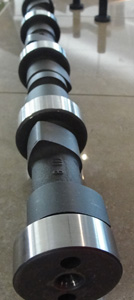Performance Diesel Engine Service Notes
June 11, 2014
Diesel performance is nothing new. What is new is the level of interest in diesels for all kinds of racing; everything from traditional truck and tractor pulling to drag racing, even sports car and endurance racing.
Diesels are setting all kinds of records from land speed to elapsed time. So if you’re not already dabbling in diesel performance, you may be soon.
Diesel engines are a different type of animal when compared to gasoline engines. While both use the same four-stroke cycle of combustion, diesels use the heat of compression rather than a spark to ignite the air/fuel mixture. A diesel engine requires a much higher static compression ratio than a gasoline engine, and on most engines there is no intake vacuum because the engine is unthrottled. Speed and power outputs are determined by the fuel injection system.
Most diesel engines are also turbocharged, yet make most of their torque and power at relatively low rpm (typically 2,500 to 4,000 rpm). However, in some forms of racing, diesels are being revved to 5,000 to 7,000 rpm).
So what does this mean to you? It means if a customer asks you to build a performance diesel engine, it’s going to take a different approach than building a performance gasoline engine. The bottom end in most diesel engines is fairly stout already, with forged steel crankshafts and beefy connecting rods, so the amount of modifications that may be needed here are usually minimal. And, because most street performance and pulling applications don’t require a lot of rpms, engine balance is not as critical as in a high revving gasoline engine.
Pistons may have to be cut, modified or replaced, however, depending on how much turbo boost the engine will be running, what kind of fuel it will be burning (diesel only, or diesel plus nitrous oxide or alcohol), and what kind of modifications are being made to the camshaft and valvetrain, which is the focus of this article.
Breathing Issues
Because diesels require a lot of compression, camshaft duration tends to be short with minimal overlap. Valve lift may also be limited by the tight piston-to-valve clearances in most diesel engines. So unlike gasoline engines, you can’t go hog wild with lift and duration to make more power. A bigger camshaft can provide more power, but only if the lift and duration are right for the turbochager, cylinder heads, pistons, valvetrain and application.
The most significant power gains in a diesel engine come from increasing the amount of boost delivered by the turbocharger(s). But there’s more to the secret than just bolting on a bigger turbo. The camshaft must have the right exhaust characteristics so it will spool up the turbo faster and keep it spinning at peak efficiency in the engine’s power band. For some types of pulling, the power band can be quite narrow, say only 2,000 to 3,000 rpm for a big agricultural diesel engine, or maybe 3,000 to 5,000 rpm for a pickup truck. A street truck, by comparison, may make most of its power from 1,800 to 3,200 rpm.
If engine speed drops too low during a truck or tractor pulling event, the turbo can stall or “chirp,” causing the boost pressure to suddenly drop. This kills power and may even cause the engine to stall.
“Less is more” is often the best advice when choosing a diesel performance cam, especially if the engine is going to be in a street vehicle.
Choosing a Cam
Always talk with the customer to find out exactly what they want to accomplish. Also, find out what kind of turbo, boost pressure and other modifications are being made to the engine so the cam grind you provide is the best one for their application.
For example, is it a street/towing application? Will they be sled pulling or drag racing?
These are important things to know when choosing a performance cam.
For street-driven daily drivers, choose a camshaft that delivers a lot of cylinder pressure — which means limiting valve overlap. You’ll want adequate separation in valve timing, but you also have to keep the lobe separation tight so you don’t run into clearance problems.
Remember, you don’t really need a lot of valve lift at low rpm on the street. Increasing lift often requires cutting piston reliefs or changing pistons.
Many diesel specialists say most diesels don’t require a lot of camshaft duration, and that different profiles for the intake and exhaust lobes deliver the best performance. In fact, one of the biggest changes seen in recent years is that improvements in turbocharger design are allowing us to use more camshaft (more duration). Turbos that were capable of producing 35 psi of boost five years ago have been replaced with turbos capable of making 60 psi of boost today.
These kinds of changes mean engine specialists don’t have to rev the engine higher to make more power — all they need to do is optimize the boost delivered by the turbo with the right sized cam. A camshaft with asymmetrical profiles for the intake and exhaust valves will deliver a broader and fatter power band.

Valvetrain Considerations
Since most diesels run at relatively low rpms, modifications that are required for the valvetrain are often minimal. This means you don’t need monster springs and pushrods to prevent the valves from floating at high speed. On the other hand, there may be some concerns about the effects of turbo boost on the intake valves.
Many diesel engines run very high boost pressures, from 80 to as much as 200 psi on some really wild racing engines. So there’s a concern that really high boost levels may overcome the force exerted by the springs on the intake valves forcing the valves open. While some diesel performance experts say that for every 10 psi increase in boost, you should use springs that are at least 10 psi stiffer than the stock springs (closed seat pressure), others say this really isn’t necessary because when the piston is coming up on its compression stroke, the pressure developed inside the cylinder will hold the intake valves shut.
On Cummins engines, there is also a concern that overly stiff valve springs may increase wear in the cam bores. In Cummins engines, there are no cam bearing inserts — the camshaft journals run directly on the machined bores in the block.
Because of this, extremely heavy valve spring pressure pushing the rocker arms, pushrods and lifters down against the camshaft may cause the bottom of the cam bores to wear out. As the cam settles lower and lower into the block, it upsets valve lift and timing, causing a significant loss of power. One way to prevent this in a performance Cummins engine with stiffer than stock valve springs is to machine out the cam bores in the block and install aftermarket
bearing inserts.
Lubrication Issues
Another concern with increasing valve spring pressure is camshaft lobe and lifter wear. Most diesel engines, with some exceptions such as Duramax and some late-model Caterpillar and International engines, still use flat tappet camshafts with flat bottom valve lifters rather than roller lifters.
The reasons for this are both economical and practical. Since most stock diesel engines run at low rpm and have relatively mild valve springs, there is not a lot of pressure on the cam lobes. Consequently, less expensive flat bottom lifters are usually fine to use. But when a diesel engine is modified for performance (and stiffer valve springs are installed to allow higher engine speeds), the increased load may cause rapid cam lobe and lifter wear — unless a racing oil or crankcase additive that contains an adequate level of ZDDP (Zinc Dialkyl Dithio Phosphate) is used.
In recent years, ZDDP levels in motor oil have been sharply reduced to prolong the life of the catalytic converter. Historically, ZDDP has been added to oils in concentrations of around 0.15% for phosphorus and 0.18% for zinc. But when “SM” rated motor oils appeared in 2005, phosphorus levels were reduced to 0.08%, or roughly half that of the previous generation of motor oils.
The same problem affects both gasoline and diesel engines that are still using flat tappet camshafts. The remedy is to coat the cam lobes with high pressure assembly lube, and to use a crankcase additive or racing oil that contains adequate levels of ZDDP. Or, convert the valvetrain from flat tappet to a roller cam and lifters (if available).
Related Course

Saving Your 6.0 Powerstroke - Full Course
Ford’s 6.0L Powerstroke diesel is a powerful torque monster, celebrated by Ford enthusiasts everywhere, but like every engine, it is not without its common issues and factory limitations. In this class, Saving Your 6.0 Powerstroke, Ron Bilyue dissects the common inherit problems with the 6.0L Powerstroke and how to fix them using enhanced aftermarket parts utilized in the performance industry. Don’t just replace parts with the same thing from the factory that failed in the first place, upgrade and never worry about that component failing again. These parts will ensure a longer life than Ford factory replacement parts that caused the issue in the first place.


